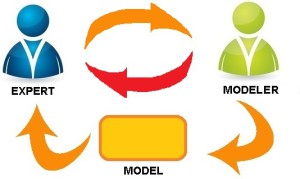Building a simulation model implies to have a very comprehensive knowledge of the existing system. We are very far from using a flowchart, even a very complex one. In the case, very typical, of a model on a production system, the modeler must understand the nature of the various flows, the logic driving their progress, the priorities for conveying and storing, the resources constraints and why each operational decision taken at every second on the production line is taken.
The Scheduling expert on the line will also have a thorough knowledge of the system. But in spite of this expertise, if he had to change some scheduling rules, and/or change priorities at one stage of the process, and/or increase batch sizes, and/or reduce the global work in progress, etc. – he would be unable (no one else would, as a matter of fact!) to predict the consequences of these changes.
That’s why we rely on industrial simulation, and that’s why modeling/simulating is a specific and full-time job…
Now, the Scheduling expert will be provided with a simulation model, where he will recognize his line with its flows and the behaviors he’s used to. He will be able to “play with the model”, in other words to run experiments, make assumptions, refine scenarios, modify lots of parameters, so as to better understand factors with a high impact or on the contrary of fine tuning, and sources for improvement. He will use better than anyone this toolbox, considering his expertise on the production line and on the company.
The expert gives the modeler information, and he translates them into a model, which will provide information to the expert. This « knowledge loop » is sometimes iterative, as the first simulations often cast light on the studied case and cause the model to be completed by alternative models or detailed sub-models.
But before that, and even before the model is finished, there is an important feed-back of information from the modeler to the expert. The information needed to build a model is not necessarily what the expert considers appropriate to describe the system. It is essential to formalize the functioning of the system, and to precisely evaluate the values of significant parameters – it implies to organize and structure information, and to quantify as much as possible. Relevant indicators must be identified, useless details about the process should be left aside, numerical values must be associated to scenarios, and often hierarchized. This thorough analysis, this “flow approach” of a system, this preeminence given back to quantitative, assessable data, this is where the modeler is the expert. It is valuable at this stage to listen to his experience and recommendations…
In general, the production expert and his colleagues (yes, it is better to have several persons involved, for confronting ideas) will already have found many answers, and obtained a better understanding of the system they imagined knowing so well – during the first discussions around the aims of the simulation and about the information the model should use.
